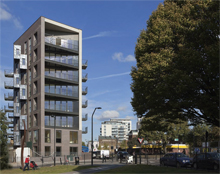Recognition and responsibility
29 June 2013As delegates to an Alliance for Sustainable Building Products event heard, certified forests and timber products can lead the way for a carbon neutral construction sector. Dr Penny Bienz reports.
An event staged earlier this year by the Alliance for Sustainable Building Products (ASBP) and co-hosted by UCL's Institute for Sustainable Resources showed positive evidence of how the forestry and forest products industry can assist in the UK government's target to make all new homes carbon neutral by 2016 and to cut CO2 emissions by at least 60% by 2050.
"Carbon sequestration from forests to buildings" was presented in the context of the Construction Products Regulation (CPR), which comes into force on July 1. The CPR includes the requirement that an Environmental Product Declaration (EPD) is used to assess the environmental impact of a product. The EPD will include details of a material's life cycle assessment (LCA). Timber and timber products' LCAs have been developed but what has not yet happened is recognition of these benefits in much of the government's planning, construction and recycling policies.
Professor Callum Hill, from Edinburgh Napier University, discussed how the carbon exchange within a mature forest is in equilibrium. Trees absorb carbon during photosynthesis and expel it during respiration and decay.
However, he said, human activity is not in equilibrium with the environment and he suggested that to address this there are things we need to do.
If we harvest wood and use it in long-term products (such as timber products in the built environment) we can increase the storage of CO2 - and the longer this carbon is stored, the better. Also, if the material containing sequestered carbon replaces a high embodied energy material derived from a non-renewable resource, then that's even better. And finally, he said, we need to grow more trees. It sounds simple.
Legislative framework
A legislative framework is being created around the forest products industries. These, said forest products consultant Professor David Robson, include the CPR and the Building Code Revision (2016), to name but two.
In his presentation Prof Robson referenced the Independent Panel on Forestry's final report which, when considering the role of trees and woods in climate change mitigation, recommended that "Government should establish a single recognised methodology to account for the full greenhouse gas benefits of using wood and timber products and permit its use as part of carbon accounting. Clear guidance should encourage the use of wood as a sustainable construction and manufacturing material". The full greenhouse gas benefits would mean a mechanism to account for the benefits of wood throughout its life cycle.
Prof Robson suggested that with the right policy decisions made by government to increase the use of (UK) wood in construction, we could see the net greenhouse gas stored in renewable construction products equate to 20% of the UK's 2050 target.
Such decisions would include that the government's planning policy be required to report embodied impact statements and targets (CO2e/m²/year); that its resource efficiency policy would ban wood into landfill - forcing design and installation techniques for better reuse and recycling; and that Building Regulations and BREEAM would value sequestered carbon in products and buildings. The government could also develop model public procurement clauses that would drive a reduction in embodied (capital) carbon.
Revision in some of these policy areas has previously been achieved, such as when the government's central timber procurement policy insisted on the use of certified timber and timber products, so further amendments are possible.
More than a substitute
Wood for Good's David Hopkins suggested that there needs to be a change in the language and that timber should not be referred to as a "substitute" or something purely innovative. There is no better opportunity than the addition of carbon accountability through developing legislation for the forestry and timber trade to now insist that it should be specified as the primary construction material, with clear justification reports required where less 'green' construction materials are specified.
There is now tangible evidence, through well-documented case studies, to support the idea that timber and timber products should be considered the primary construction material if we are looking to 'build' a low-carbon construction industry.
During the conference, Jonathan Fovargue, from Eurban, presented Bridport House, the eight-storey residential block in Hackney in London.
Bridport House used cross-laminated timber (CLT) as the main element of construction and internal finishes were carefully considered to enable the CLT components to be reused or recycled at the end of the building's lifespan. The use of timber components as the main construction element clearly provided benefits, including speedy installation and an approximate 25% reduction in foundations, thanks to the lightweight structure (62% lighter than concrete).
Substituted and sequestered
Mr Fovargue added that the combination of the stored carbon in the timber and the carbon avoided by not using a reinforced concrete frame, equalled 2,044 tonnes of substituted and sequestered carbon or, put plainly, 27 years' worth of "energy in use" for those 41 dwellings. Astonishing.
These findings were supported by Andrew Waugh of Waugh Thistleton Architects, who provided details on the nine-storey Murray Grove, also in Hackney.
Mr Waugh summarised the carbon science by stating that making a nine-storey concrete building emitted 500 tonnes of CO2, while making a nine-storey timber building stored 760 tonnes of CO2 - a net difference of 1,260 tonnes.
During a question and answer session both Mr Fovargue and Mr Waugh confirmed that certified timber was a contract specification on these projects. This has now become the norm for projects using public money and, in recognition of this, more construction companies should be looking to achieve Project Certification; such as has been seen at the London Olympic 2012 Park; or more recently at the Bullitt Centre in Seattle, which is a predominantly timber office building designed to last 250 years.
While it is recognised that the reality of large-scale modern construction may always require a mix of materials - for example, concrete and steelwork in foundations and formwork - a certified, carbon-rated timber product is the perfect solution to a green build.
Certified timber and timber products are the only construction products guaranteed from an independently verified and responsible source and the government was able to change its procurement activities to recognise this. We now look to the government to make a further amendment to its procurement policy to promote timber and timber products as the primary construction material in recognition of timber's sequestered carbon and substitution for carbon emitting non-renewable products.
Central government is key to regenerating this industry sector and supporting proper carbon accounting for forest products. It is not enough to run a public body or grant system which plants and manages woodlands, grows timber, and then stops there. There should then be support for a UK-based timber processing industry to supply products to architects and engineers looking to build that highest rating of eco-home.
Time to talk
ASBP's Graham Hilton suggested that "government needs to recognise its [UK] wood stocks... and then to understand its responsibilities to them". However, we must not wait for this. We must talk now, through Wood for Good and our trade press, to construction companies, engineers and architects. We have everything to gain, and so does planet earth.


